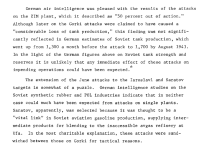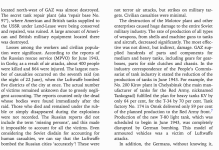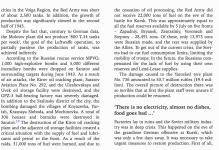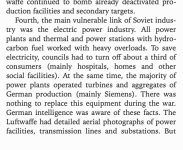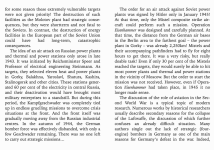What if Operation Eisenhammer was launched in June 1943 instead of the bombing campaign against Gorky?
For those who are unfamiliar:

 en.wikipedia.org
en.wikipedia.org

 en.wikipedia.org
en.wikipedia.org
Historically the plan to bomb Soviet electrical stations was only fully developed by late July 1943, despite the author of the plan pushing for it since before the war started and again against Britain during the Blitz. He was only listened to after the Luftwaffe restarted strategic bombing in summer 1943 right before Kursk to damage Soviet production before the planned battle to destroy their armor reserves at Kursk. As a POD here the Luftwaffe listens to him in winter-spring 1943 and instead of going after the factories of Gorky, they instead use their resources to hit the 11 power stations identified in the Eisenhammer plan (technically still called Aktion Russland in 1943), some of which were in Gorky. All the elements of the plan were basically ready to go or could be made so in time if the plan was ready, such as the Fritz-X PGM, all they lacked was the plan to actually do it, though that existed conceptually already. The Mistel part only came in 1944, but was unnecessary to the plan, as that part would have only cut off civilian power to Moscow after factory power was already cut.
The impact, if successful, which given the success in bombing Gorky in June 1943 should be entirely doable with existing resources, would have been catastrophic for the Soviets and could not have been repaired in less than 18 months.
The impact:
The loss of only 50 per cent of the electricity supply is sufficient to paralyze the major consumers among the armaments industry.
The following depend on the electricity supply in the Moscow-Upper Volga region alone:
80 per cent of tank engine production
50 per cent of electronics production
60 per cent of light tanks and motor vehicles
50 per cent of howitzers, optical instruments, et cetera.
Coupled with the vast losses during Kursk and the Soviet counteroffensives, they would run out of tanks in 1943. Historically they produced about 20k and lost 20k in combat that year (same for 1944), but here they would have the power cut off in June, so at best they produce about 13k tanks for the entire year and no more than 5k in 1944 until they can replace the lost equipment. Since production of such things took at least 12 months and they'd have to ship and install it from the US, since the USSR did not manufacture it at home, 1945 would be the earliest they could restore production to 1943 pre-bombing levels.
Essentially their September offensives would be the end of the line for the year unless they wanted to keep attacking with just infantry in limited attacks with whatever equipment they could muster or the US was willing to ship them lots of manufactured AFVs instead of raw materials and other production related stuff. This effectively means that 3rd and 4th quarter 1943 would mean they are only able to launch very limited attacks which the Germans could counter with the resources at hand, while focusing more and more on the west. This very well may mean they could retain the Panther Line:

 en.wikipedia.org
en.wikipedia.org
The Soviets also lose out on the liberated manpower in the occupied parts of Ukraine that were vital to maintaining their frontline strength, as their primary source of replacements from 1943-45 was manpower from liberated territories.
What would this mean for the rest of the war with the Soviets crippled so badly right before Kursk?
For those who are unfamiliar:

Operation Eisenhammer - Wikipedia

Bombing of Gorky in World War II - Wikipedia
Historically the plan to bomb Soviet electrical stations was only fully developed by late July 1943, despite the author of the plan pushing for it since before the war started and again against Britain during the Blitz. He was only listened to after the Luftwaffe restarted strategic bombing in summer 1943 right before Kursk to damage Soviet production before the planned battle to destroy their armor reserves at Kursk. As a POD here the Luftwaffe listens to him in winter-spring 1943 and instead of going after the factories of Gorky, they instead use their resources to hit the 11 power stations identified in the Eisenhammer plan (technically still called Aktion Russland in 1943), some of which were in Gorky. All the elements of the plan were basically ready to go or could be made so in time if the plan was ready, such as the Fritz-X PGM, all they lacked was the plan to actually do it, though that existed conceptually already. The Mistel part only came in 1944, but was unnecessary to the plan, as that part would have only cut off civilian power to Moscow after factory power was already cut.
The impact, if successful, which given the success in bombing Gorky in June 1943 should be entirely doable with existing resources, would have been catastrophic for the Soviets and could not have been repaired in less than 18 months.
The impact:
The loss of only 50 per cent of the electricity supply is sufficient to paralyze the major consumers among the armaments industry.
The following depend on the electricity supply in the Moscow-Upper Volga region alone:
80 per cent of tank engine production
50 per cent of electronics production
60 per cent of light tanks and motor vehicles
50 per cent of howitzers, optical instruments, et cetera.
Coupled with the vast losses during Kursk and the Soviet counteroffensives, they would run out of tanks in 1943. Historically they produced about 20k and lost 20k in combat that year (same for 1944), but here they would have the power cut off in June, so at best they produce about 13k tanks for the entire year and no more than 5k in 1944 until they can replace the lost equipment. Since production of such things took at least 12 months and they'd have to ship and install it from the US, since the USSR did not manufacture it at home, 1945 would be the earliest they could restore production to 1943 pre-bombing levels.
Essentially their September offensives would be the end of the line for the year unless they wanted to keep attacking with just infantry in limited attacks with whatever equipment they could muster or the US was willing to ship them lots of manufactured AFVs instead of raw materials and other production related stuff. This effectively means that 3rd and 4th quarter 1943 would mean they are only able to launch very limited attacks which the Germans could counter with the resources at hand, while focusing more and more on the west. This very well may mean they could retain the Panther Line:

Panther–Wotan line - Wikipedia
The Soviets also lose out on the liberated manpower in the occupied parts of Ukraine that were vital to maintaining their frontline strength, as their primary source of replacements from 1943-45 was manpower from liberated territories.
What would this mean for the rest of the war with the Soviets crippled so badly right before Kursk?



